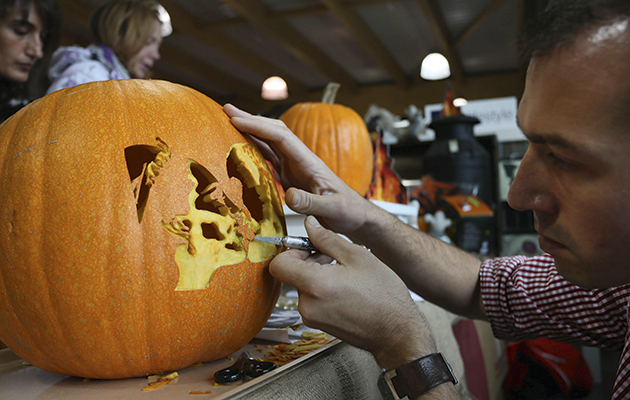From flavouring lattes and pies to glowing as jack-o'-lanterns by night, the pumpkin is a familiar sight come Halloween. But it is a relative newcomer, explains Emily Arbuthnott, having bested the turnip in party popularity
The pumpkin heralds shorter days and spooky happenings come autumn and Halloween. From lighting doorsteps as jack-o’-lanterns to flavouring soups, coffees and pies, it is the definitive symbol of All Hallows’ Eve. But the pumpkin is a newcomer, says Emily Arbuthnott, having bested the humle turnip. So how did the orange invader gain the upper hand?
Test your nerves ahead of Halloween this weekend by reading the stories of haunted country houses. Are you afraid of things that go bump in the night?
THE ORIGINAL HALLOWEEN LANTERN
Vikings ate turnips. This hard vegetable is rooted in the British culinary repertoire, be it bashed and served with haggis in Scotland, simmered in Welsh lamb cawl or used as a staple in the standard stew of the English. The original Halloween lantern was a turnip. The Irish gave this idea to the Americans. And there, in the great US of A, turnips gave way to pumpkins as rugby did to American football, as single malt to bourbon.
The Americans, never ones to hide their light under a bushel (or inside a brassica), are more passionate about pumpkins than they are about baseball; and it goes farther than the lantern. In 2013 Americans spent more than $15 million on pumpkin-flavoured beers. Pumpkin-flavoured cider and pumpkin-flavoured Dunkin’ Donuts, bagels, cookies, pretzels and M&Ms are avidly consumed on the other side of the Pond over the Hallowe’en period. Starbucks spiced-pumpkin latte, which arrived in the UK in 2012, has its own Twitter account.

3,000 pumpkins carved by professional carvers as well as members of the public are lit up for Halloween in London.
There is hardly any actual pumpkin content in any of these products. With pumpkins it’s all about the show. Unlike the turnip, you can’t have the lantern and eat it. When saw comes to scoop pumpkins are, in fact, rather hollow. The majority of US pumpkin pie fillings come from tinned purée as to make your own involves roasting, skinning and then puréeing the fresh vegetable, leaving nothing from which to create a lantern. As a result, many redundant lanterns are discarded rather than devoured, which is a shame. Hubbub, founder of Pumpkin Rescue, which is organising the #pumpkinchallenge to “squash” food waste, argues that 18,000 tonnes of perfectly edible vegetable is tipped straight into the bin every Hallowe’en: the equivalent weight of 1,500 double-decker buses. No such scandal taints the turnip. Admittedly, a few fingers may be lost in the process of hacking out the solid flesh but once the job is done, that’s supper sorted: a bit of buttery mashed neeps with sausages.
THE CRAFT OF PUMPKIN CARVING

Guinness World Record pumpkin carving champion, Dave Finkle, puts the finishing touches to the Duke and Duchess of Cambridge’s faces, which he is carving out of a pumpkin, at Dobbies Garden Centre in Gillingham, Kent.
It follows that carving pumpkins has become more than a ritual; it has become a craft. Dave Finkle, the double world champion pumpkin carver, explains: “There is a great amount of intricate detail involved. You need to be very patient and have a very steady hand, like a surgeon. Every pumpkin I carve takes up to four hours. Americans carve over a billion pumpkins each year but we are catching up.”
Finkle’s first foray into pumpkin sculpting happened when his village, Little Barrow in Essex, decided to hold a charity pumpkin-growing competition. “My mother-in-law beat me. So, not to be outdone, I organised a carving competition, which I won, and that’s where it all started.”
Before you can say “book group”, local carving classes and competitions are gathering momentum the length and breadth of the UK with an estimated 95% of the 10 million UK pumpkins grown being scored into something scary. One carver, Georgina Burke, even managed to etch a picture of Pippa Middleton’s bottom from the royal wedding on to her pumpkin. Finkle himself has crafted pumpkins for an array of clients from Fortnum & Mason to Harrods and Tate Modern. “The BBC telephoned and asked if I would carve the face of each Strictly Come Dancing judge into a pumpkin, for their Halloween special.” Finkle is aware of rumours that his world championship title will be challenged this year but he is unfazed and remains inundated with requests. “What blows people’s minds with my creations is that they can make little sense of what I have sculpted in daylight; then, once the candle in the pumpkin is lit and the lights are off, the whole thing transforms. It’s like magic.”
THE TURNIP: A DANGEROUS VEGETABLE
The same can’t be said for a turnip, which is pretty terrifying-looking before the scalpel has been sharpened. Success is to have scored something resembling eyes and a mouth and still have both hands intact. But then turnip carving is not for the faint-hearted. When Just-Eat polled customers to coincide with National Food Safety week the turnip topped the most dangerous vegetable list. There is something immensely satisfying in that. Children stand back! Kitchen knife, turnip and tea light are all that is needed here. One of the pros of the pumpkin is meant to be its “child-friendly” aspect but do adults really surrender their keyhole saws for cutting off the top, wood gouges, hole cutters and power drills to their interfering offspring?
The turnip might not have mass market appeal, its own emoji (yet) or come in an array of varieties and colours with names such as “Cinderella” or “Munchkin”. Nevertheless, there is something rustically charming, un-assuming and traditional about the turnip; it’s a toy soldier to the pumpkin’s Barbie. There is no denying the gritty, deep-rooted heritage of a neep that stirs that wonderful form of British patriotism – we had to suffer them and so can the next generation.






